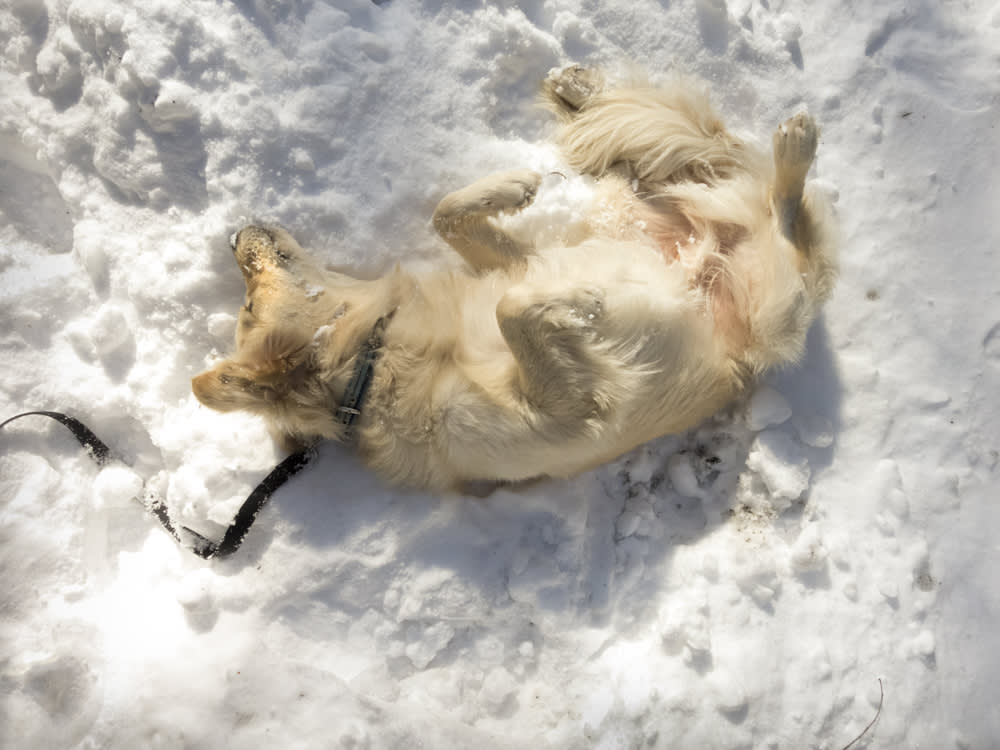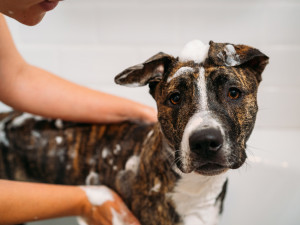Natural Remedies for Dry Skin: How to Help Dry Skin on Dogs
Spoiler: These at-home remedies are probably already in your pantry.

share article
In this Article:
Causes of Dry Skin on Dogsopens in a new tab Symptoms of Dry Skin on Dogsopens in a new tab Home Remedies For Dry Skin on Dogs opens in a new tab When to Visit the Vet for Dry Skin on Dogsopens in a new tab
It’s winter. The air is dry, and our skin is even dryer. Your dog is no exception when it comes to these uncomfortable, itchy-scratchy months. But if your pup starts scratching more than occasionally, consult with your vet to find the root cause of the problem.
To help your dog’s dry skin, consider bathing them less frequently, using a moisturizing shampoo made for dogs, and applying coconut oil or vitamin E oil to their skin. You can also add omega-3 fatty acidsopens in a new tab to their diet and consult with a veterinarian to rule out any underlying medical conditions. Read on for more suggestions to help your dog as you both welcome this cold, dry January.
What causes dry skin on dogs?
Doggie dandruff, or scaling, is often caused by some form of seborrheic dermatitis. Seborrheic dermatitis occurs when the sebaceous glands of the skin produce an excessive amount of sebum, leading to dry, itchy, and flaky skin. Abnormal sebaceous gland function can lead to excessive greasiness or excessive dryness.
Some conditions that lead to dry skin in dogs require prescription medications and specific treatment. If your dog is severely itchy,opens in a new tab consult with your veterinarian to determine the best course of action before jumping into natural remedies. Causes of dry skin on dogs include:
Allergies: food allergies, flea allergy dermatitisopens in a new tab, allergens like pollen
Environmental factors: low humidity climate, dry indoor heat
Infection: yeast, bacteria
Parasites: fleas, mites (Demodexopens in a new tab, scabies, lice, etc)
Excessive grooming (bathing too frequentlyopens in a new tab or using harsh shampoo)
Underlying congenital, immune-mediated, or endocrine disorders
What are the symptoms of dry skin on dogs?
Constant scratching is typically a dog parent’s first clue that their dog has dry skin. Symptoms of dry skin in dogs include:
Scaling/dandruff
Itching
Abrasions (from excessive scratching)
Red, inflamed skin
Dull coat
Odor
Which home remedy is right for my dog’s dry skin?
Before pursuing natural treatment for your dog’s dry skin, consult with your veterinarian. Underlying conditions, such as skin mites, infections, or endocrine disease require specific treatment and could worsen while waiting to see if home remedies work. After your vet rules out certain medical conditions, you may try some homemade remedies for your dog’s dry, flaky skin.
How to use olive oil for your dog’s dry skin
Extra-virgin olive oil (EVOO) is the best choice for dogs. Cold-pressed, unrefined, and made from the first olive pressing, it’s less acidic than more processed forms of olive oil, and as a result, easier on the canine digestive system. It also has higher levels of vitamins and antioxidants.
Dogs who may have a hard time digesting omega-3 and omega-6 fatty acids usually do well with olive oil. Aside from its ability to repair dry, flaky skin and shine up your dog’s coat, olive oil may also perk up their appetite and help with constipation. The only downside is olive oil can go rancid quickly, which is why it’s sold in dark-colored bottles. Store it in a cool, dark place away from heat sources (not on a sunny counter or near the stove) to ensure it lasts.
Olive oil daily dose guidelines:
Small dogs: 1/2 teaspoon
Medium dogs: 1 teaspoon
Large dogs: 2 teaspoons
Extra-large dogs: 1 tablespoon
How to use coconut oil for your dog’s dry skin
You’re also likely to have coconut oil in your pantry. It’s high in saturated fat and contains quickly absorbed medium-chain triglycerides and fatty acids, which are thought to help with a number of canine conditions, including itchy or dry skin, odor, allergic reactions, and yeast and fungal infections. Like olive oil, the best coconut oils for dogs are organic, virgin, and cold-pressed. This oil comes in a range of flavors — bold, buttery, bland, nutty — so you may need to experiment to see which one your dog prefers with their food. (Some dogs are put off by a strong coconut flavor.)
Coconut oil can be added to food or — for a particularly dry or itchy patch — massaged directly into a dog’s skin. If applying topically, be super-conservative in the amount you use and supervise your dog afterward until the oil’s been absorbed. Your dog will probably try to lick it off, and too much coconut oil at once can cause stomach upset.
Coconut oil daily dose guidelines:
Small dogs: 1/4 teaspoon
Medium/large dogs: 1/2 to 2 teaspoons
Extra-large dogs: 1 tablespoon
Note: If your dog is prone to pancreatitiopens in a new tabs, check with your vet before adding coconut oil (or any oil) to their food. Otherwise, introduce it gradually.
How to use fish oil for your dog’s dry skin
While it’s a less common pantry item, fish oilopens in a new tab is a go-to supplement thought to support canine heart health, reduce itching and skin flaking, and relieve allergies and joint pain. When selecting a fish oil for your dog, check the manufacturer’s certificate of analysis. A blend derived from salmon, herring, sardines, and other small fish will offer the most omega-3s and the longest shelf life.
Something to be aware of, though, is that fish oil can prolong blood clotting time, so if your dog requires surgery, be sure to tell your vet about this supplement. The vet may ask you to discontinue it for a few days before and after the procedure. Additionally, in processing fish oil, a dog’s system can use up its supply of vitamin E. This can leave the dog with a deficiency, which has its own set of problems. Ask your vet if this is something to be concerned about with your dog.
How to use vitamin E oil for your dog’s dry skin
Vitamin E has antioxidant properties, meaning it can protect cells from damage from free radicals. This includes damage from UV rays and inflammation. Some dogs with canine atopy (allergic skin disease) have shown improvement with vitamin E supplementation.
Vitamin E is a fat-soluble vitamin, meaning it can build up in the bloodstream and lead to overdose. Too much vitamin E (acutely or over time) can cause nausea, muscle weakness, lethargy, and impaired blood clotting. Vitamin E deficiency is rare in dogs, so talk to your veterinarian before starting oral supplementation.
How to use apple cider vinegar for your dog’s dry skin
Apple cider vinegar (ACV) is made from fermented apple juice. It’s used for cooking, but is also believed to have many health benefits, including for skin. Apple cider vinegar has antiseptic properties, and its acidity can help manage mild yeast infections. But that acidity also means it can burn. Apple cider vinegar must be diluted and cannot be used on broken or irritated skin.
When using ACV for dry, flaky skin, dilute the apple cider vinegar (1:1 ratio) with distilled or purified water. Keep the mixture in a spray bottle and mix well before using. Just like when you introduce an acid to your own skincare regimen, patch testing is recommended to look for unexpected sensitivity. Diluted ACV can be used as a leave-on or can be washed off. Understandably, not all pet parents appreciate the smell. Stick to topical apple cider vinegar for dry skin. Oral ACV is unlikely to benefit the skin and can cause GI upset, esophageal irritation, and tooth enamel erosion. Adding ACV to water may deter your dog from drinking enough water, leading to dehydration.
How to use plain, unsweetened yogurt for your dog’s dry skin
Probiotics, like Lactobacillus, have been shown to decrease itchinessopens in a new tab in dogs with allergic skin disease. Probiotics help maintain a balanced microfloraopens in a new tab in the gut, promoting overall whole-body health. Plain, unsweetened yogurt can be an easy source of probiotics for dogs. Be sure to only feed yogurt that is plain and unsweetened. Without preservatives is best. Flavored or sweetened varieties may have too much sugar or harmful artificial sweeteners like xylitol, which is toxic.
A little goes a long way when giving yogurt to your dogopens in a new tab. A medium-sized dog can benefit from one tablespoon per day. Some pup parents may be tempted to apply yogurt to their dog’s skin. Topical yogurt can be pretty messy and its efficacy is not well-established. Plus, you may just be creating a moist environmentopens in a new tab for more organisms to grow.
Don’t go overboard with oil
The saying “a little goes a long way” definitely applies here. Too much oil can result in the following:
Diarrheaopens in a new tab, greasy stools, or digestive upsets
Weight gainopens in a new tab: Take the calories oil adds into account. Both coconut and olive oils clock in at about 40 calories per teaspoon.
Pancreatitis: A large helping of oil can provoke an inflammation of the pancreas, particularly in dogs who are prone to it.
Start introducing oil slowly and see how your dog tolerates it. After a couple of weeks, if no problems arise, consider increasing the dose slightly.
When should I take my dog to the vet for dry skin?
Many small animal veterinarians can attest to the fact that skin issues make up a good portion of conditions treated in dogs and cats. So rest assured: You’re not alone when seeking help for your dog’s dry, itchy skin. Some dogs only have occasional issues with dry skin, while others really need medical intervention. See you vet if your dog:
Can’t get comfortable because they’re scratching too much
Has skin that is red, inflamed, or broken
Has a strong odor
Seems unwell in any way
Your vet will perform a thorough physical exam and may recommend diagnostic testing to try to get to the bottom of your dog’s skin issue. Testing may include performing an impression smear (microscopic examination of what’s living on the skin surface), skin scraping, skin culture, or blood work.
These steps ensure that underlying infections, infestations, and endocrine conditions are treated properly. Sometimes there is no “cure” for dry dog skin; management is the only option. If your dog’s skin problems are chronic or severe, it might be time to talk to a veterinary dermatologistopens in a new tab.
FAQs (People also ask):
Are there specific breeds prone to dry skin?
Any dog breed can suffer from dry skin, but some breeds are more prone to the condition including English Bulldogs, Cocker Spaniels, Springer Spaniels, Doberman Pinschers, and West Highland Terriers.
How often should I bathe my dog to prevent dry skin?
Bathing frequency depends on your dog’s coat, environment, and how often they actually get dirty. To help prevent dry skin, be sure to not bathe too frequently, use gentle dog shampoo, and skip blow drying.
Can diet help with dry skin on dogs?
Feeding your pup a complete and balanced diet formulated for dogs can help to prevent any nutritional deficiencies that can contribute to dry skin. Dogs with dry skin from food allergies can benefit from diet changes that eliminate potential triggers.
Are there supplements my dog should take to help with dry skin?
Fish oil is a commonly recommended dry skin dog supplement. Not all dogs can tolerate fish oil, though, so consult your veterinarian before starting any supplementation to determine the best options for your dog.
References:
Susan Tasaki
Freelance writer Susan Tasaki lives in the San Francisco Bay Area with her Husky, who wishes they both got out more.

Dr. Alycia Washington, DVM, MS
Alycia Washington, DVM, is a small animal emergency veterinarian based in North Carolina. She works as a relief veterinarianopens in a new tab and provides services to numerous emergency and specialty hospitals. Dr. Washington is also a children’s book author and freelance writer with a focus on veterinary medicine. She has a special fondness for turtles, honey bees, and penguins — none of which she treats. In her free time, Dr. Washington enjoys travel, good food, and good enough coffee.
Related articles
![A woman sitting in a chair holding a dogs paw in her hand and holding the dogs face in the other hand.]() opens in a new tab
opens in a new tab6 Natural Paw Balms That Will Keep Your Pup Safe From Summer Heat
The best paw balms, based on veterinarian recommendations.
![dog using diy paw wax to protect paws in snow standing next to fence]() opens in a new tab
opens in a new tabCold Weather Is the Nemesis of Dog Paws. Here’s How to Help
We all have to up our moisturizing game in the fall and winter.
![Cheerful Brunette Having Fun With Her Dog Outside]() opens in a new tab
opens in a new tabBig Fish: The Best Omega-3 Supplements for Dogs (And Why They Need Them)
Fatty acids rev up your dog’s energy, keep their coat shiny, help with inflammation from allergies and arthritis, and so much more.
![A happy looking man and woman walking their dog outside in a large snowy field.]() opens in a new tab
opens in a new tab7 Ways to Keep Your Pup Cozy on Snowy Days
A professional dog walker’s pro tips for making winter your dog’s favorite time of year.
![Pit Bull dog wearing a coat on leash with person in the snow]() opens in a new tab
opens in a new tabDoes Your Dog Need a Winter Coat?
Chilly pup refusing to layer? Here’s how to train them to love their winter wardrobe.
![Happy Chihuahua dog running outdoors wearing blue jacket in winter snow]() opens in a new tab
opens in a new tab23 Winter Trappings for the Dog With Outdoorsy Parents
Ski-club balaclavas, waterproof wellies, all-natural nose balm, and more gear to help outdoorsy pet parents get the most out of the season.









